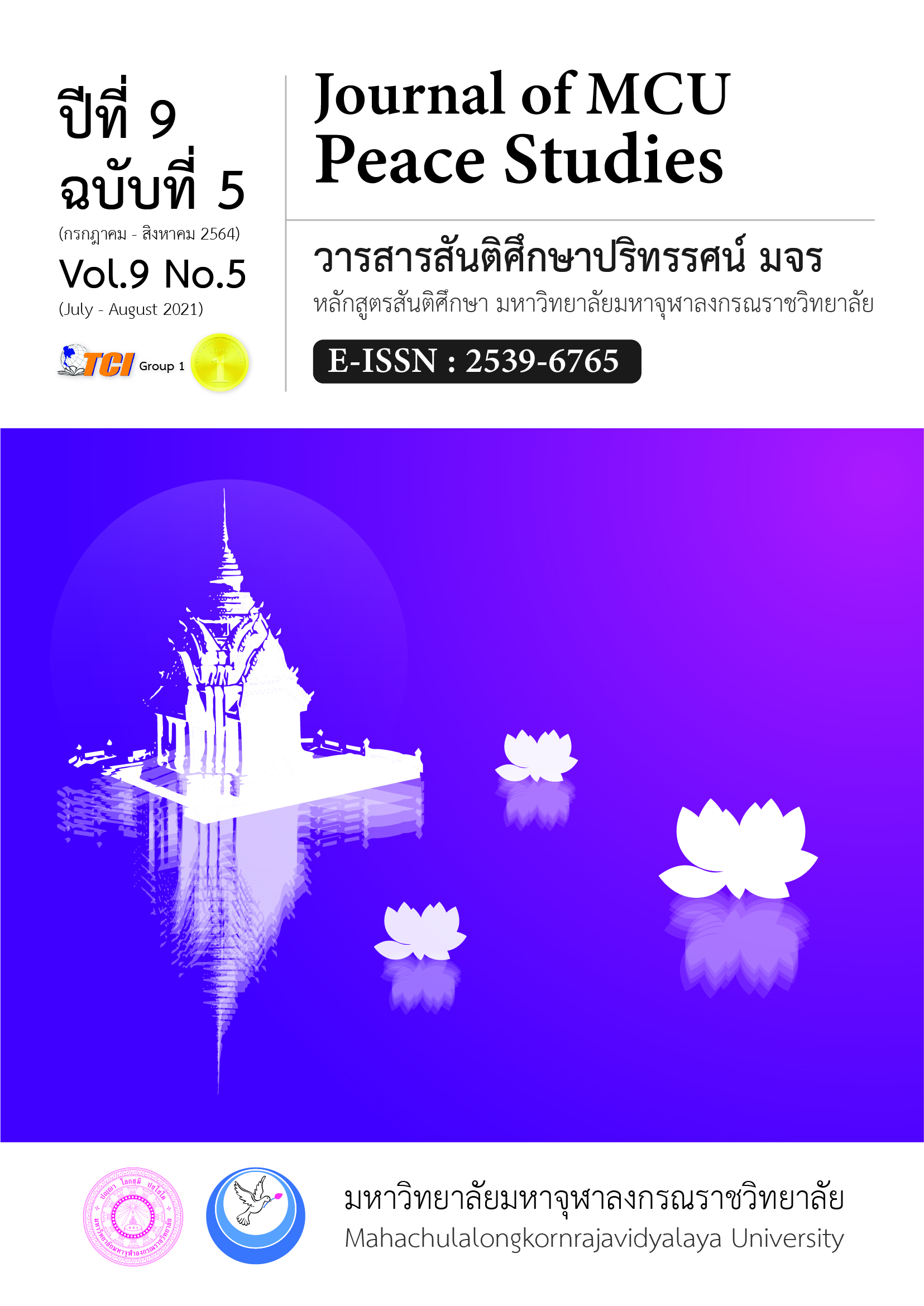ผลของโปรแกรมฝึกอบรมเพื่อพัฒนาความผูกพันในครอบครัวของวัยรุ่น
Main Article Content
บทคัดย่อ
บทความนี้มีวัตถุประสงค์เพื่อศึกษาผลของโปรแกรมฝึกอบรมเพื่อพัฒนาความผูกพันในครอบครัว ของวัยรุ่น โดยใช้ทฤษฎีการบำบัดด้วยสติ และการปรับเปลี่ยนความคิดและพฤติกรรม เป็นการวิจัยกึ่งทดลองโดยใช้กระบวนการเลือกแบบเฉพาะเจาะจง กลุ่มตัวอย่างที่ใช้ คือ นักเรียนระดับชั้นมัธยมศึกษาปีที่ 1 - 3 ปีการศึกษา 2562 แบ่งเป็นกลุ่มทดลอง และกลุ่มควบคุม กลุ่มละ 8 คน กลุ่มทดลองได้เข้ารับโปรแกรมฝึกอบรมเพื่อพัฒนาความผูกพันในครอบครัวของวัยรุ่น ทั้งหมด 9 ครั้ง ครั้งละ 90 นาที สัปดาห์ละ 1 ครั้ง การเก็บข้อมูลก่อนและหลังการทดลอง ใช้แบบประเมินความผูกพันในครอบครัวของวัยรุ่น เปรียบเทียบค่าเฉลี่ยคะแนน ความผูกพันของกลุ่มทดลองและกลุ่มควบคุม ก่อนและหลังได้เข้ารับโปรแกรมฝึกอบรมเพื่อพัฒนาความผูกพันในครอบครัวของวัยรุ่นด้วยสถิติชนิดไม่เป็นอิสระต่อกัน และเปรียบเทียบผลต่างของค่าเฉลี่ยคะแนนก่อนและหลังได้เข้ารับโปรแกรมฝึกอบรมระหว่างกลุ่มทดลอง และกลุ่มควบคุมด้วยสถิติชนิดเป็นอิสระต่อกัน ผลการวิจัยพบว่า 1) ค่าเฉลี่ยคะแนนในกลุ่มทดลองหลังได้รับโปรแกรมฝึกอบรมสูงกว่าก่อนการทดลอง อย่างมีนัยสำคัญทางสถิติ 2) ผลต่างค่าเฉลี่ยคะแนนก่อนและหลังได้รับโปรแกรมฝึกอบรมระหว่างกลุ่มทดลอง และกลุ่มควบคุมมีความแตกต่างกันอย่างมีนัยสำคัญทางสถิติ แสดงให้เห็นว่าโปรแกรมการฝึกอบรมมีประสิทธิผลในการพัฒนาความผูกพันในครอบครัวของวัยรุ่นได้ ดังนั้นโปรแกรมพัฒนาความผูกพันในครอบครัวของวัยรุ่นจึงเป็นโปรแกรมที่มีประโยชน์และมีประสิทธิผล
Article Details
ทัศนะและความคิดเห็นที่ปรากฏในบทความในวารสาร ถือเป็นความรับผิดชอบของผู้เขียนบทความนั้น และไม่ถือเป็นทัศนะและความรับผิดชอบของกองบรรณาธิการ ยินยอมว่าบทความเป็นลิขสิทธิ์ของวารสาร
เอกสารอ้างอิง
Cooper, M.L., Shaver, P.R., & Collins, N.L. (1998). The style of attachment, emotional control and adaptation in adolescents. Journal of Personality and Social Psychology, 74(5), 1380–1397.
Department of Community Development. (20 0 0). Factors that support the strength of the family institution. Research report. Retrieved September 15, 2018, from http://www.iqeqdekthai.com
Dinkmeyer, D., Sr., G. D., & McKay, Jr. (1997). Systematic Training for Effective Parenting [VHS]. Circle Pines, MN:American Guidance Service.
Friesen, J. D. (1990). Rituals and Family Strength. Retrieved August 12, 2019, from http://www.directionjournal.org/article/?564.
Kabat-Zinn, J. (2003). Mindfulness-based interventions in context: past, present, and future. Clinical psychology: Science and Practice, 10(2), 144-156.
Markiewicz, D., Doyle, A.B., & Brendgen, M. (2001). The quality of adolescents’ friendships: Associations with mothers’ interpersonal relationships, attachments the parents and friends, and prosocial behaviors. Journal of Adolescence, 24(3), 429–445.
National Committee for Promotion and Coordination of Women. (1994). Seminar on brainstorming on promoting family institutions to be strong and self-reliant. Bangkok: Office of the National Culture Commission.
Poverny, L.M., & Finch, W.A. ( 1988) . Gay and lesbian domestic partnerships: Expanding the definition of the family, Social Casework, 69(2), 116-121.
Ramchitti Institute. (2008). Children and youth behavior. Youth and Youth Situation Monitoring Program. Bangkok: Chulalongkorn University Press.
Kongsakon, R. (2013). Special article. Villagers Doctor Magazine. Retrieved July 1, 2019, from http://www.gotoknow.org/posts/421799.
Samuelson, M., Carmody, J., Kabat-Zinn, J., & Bratt, M. A. (2007). Mindfulness-based stress reduction in Massachusetts correctional facilities. The Prison Journal, 87(2), 254-268.
Threepati, S. (2009). Risk factors and prevention or promotion of adolescent health. Retrieved July 20, 2019, from http://www.wearehappy.in.th/happykids/happykidsteen/.


